VR for Training: 2022 Guide to Create Your VR Training Solution

Today virtual reality (VR) technology is gaining momentum. Research indicates that by 2030, 23 million jobs globally will be set to use virtual reality staff training programs. This is not surprising. Staff training involves risks, safety problems, and complex learning scenarios. However, VR technology brings tremendous advantages to staff training routines.
If you are thinking about implementing VR technology into your employees’ training process, you’re in the right place.
This comprehensive guide explains how businesses from various industries can benefit from a custom VR training app, describes the critical features required to create a custom virtual reality training software, and provides approximate development costs.
All content is based on real-life case studies Alternative-spaces has developed. We will share the exact information below.
Let’s get started!
What is virtual reality training?
Virtual reality training is an artificial digital environment that allows trainees to simulate workplace scenarios for training and upskilling. Today VR technology allows for replicating various real-life scenarios in a classroom environment, such as disaster preparedness or realistic heights training.
VR training completely replaces the real world. And such a fully immersive experience enables trainees to enhance their professional skills without risks.

Virtual reality training solutions provide trainees with a realistic learning environment that simulates any world. Using VR headsets, controllers, or additional sensors connected to a smartphone or computer, they can interact with objects and other people. VR training solutions provide an excellent opportunity for businesses to train their staff in 3D environments without real-world risks.
However, safety is not the only advantage that VR offers as a training tool. Below we’re going to describe why VR training simulators have become a real successor in many industries and consider the key virtual reality training benefits.
What are the benefits of virtual reality training?
VR training app has the potential to grant compelling benefits to businesses of various industries. Let’s review them.
Reducing training time and costs
In most cases, the training process can be quite expensive. For example, сomprehensive and real training of healthcare experts or firefighters could cost a lot more, including employees’ well-being and, even possibly, their lives. For this reason alone, it’s a required initial investment. However, VR also allows avoiding repeated courses and paying experienced trainers potentially high salaries compared to traditional training.
Moreover, VR training solutions can speed up the ramp-up period for your trainees. As practice shows, employees who trained using VR completed training up to four times faster than the classroom and e-learn training. As a result, the quicker an employee can begin working, the faster you can enjoy a positive ROI.
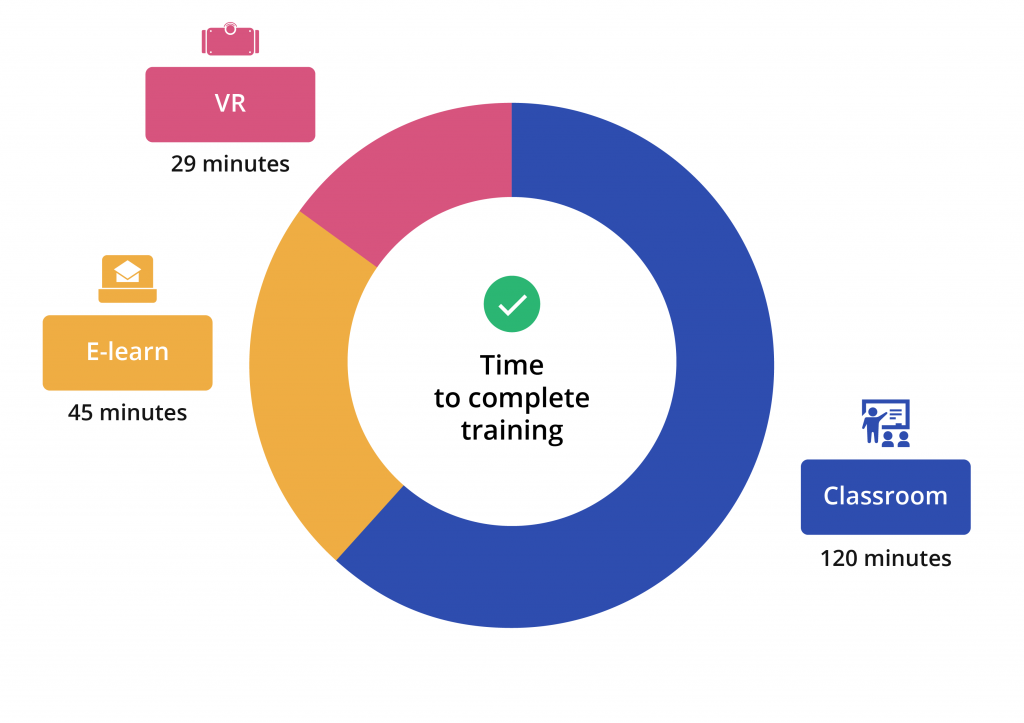
Safety
This is probably one of the most significant benefits of virtual reality. VR training solutions allow your learners to encounter true-to-life scenarios without facing real-world risk. Many scenarios enable trainees to improve their skills, learn how to complete dangerous tasks carefully, and learn from mistakes in a safe environment.
Training flexibility
You can easily add or change scenarios and modify the environment and objects, which cannot necessarily be said about the settings of physical elements.
Moreover, if you have the required software, hardware, and power supply source, you can use VR training software nearly everywhere and at any time. This flexibility provides access to training for staff working on different schedules.
Enhanced staff productivity
VR enables employees to simulate the real world and experience various complex tasks. Thanks to this immersive and realistic experience, trainees receive hands-on experience without the risk.
VR training simulation allows employees to practice an almost unlimited number of times, which will enable them to hone their professional skills as much as possible while improving their performance.
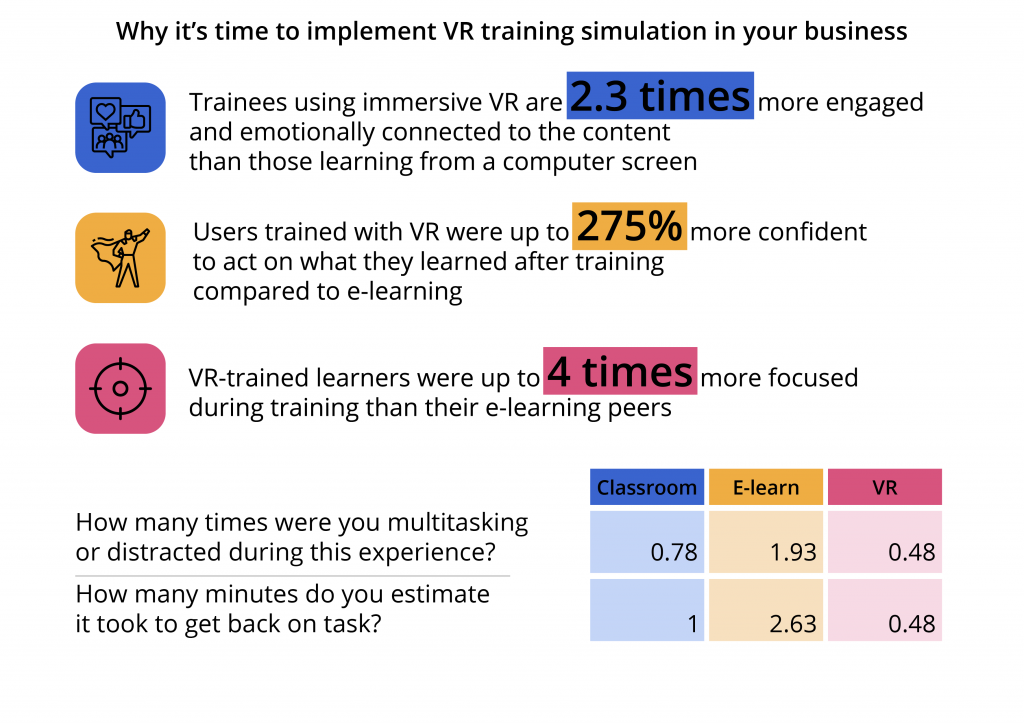
As you can see, VR training simulation provides excellent benefits and holds tremendous promise for businesses right now. But how can companies implement and leverage VR training simulation? Below we show you the most promising VR training simulation opportunities for businesses and real-life examples.
Use cases for VR training simulator
Construction
The construction industry is known for being hazardous. And VR training simulations allow for modernizing construction working practices and building a safe and risk-free working environment.
3D imitation and VR technology allow for reproducing dangerous situations, preparing staff for emergencies such as problems with the construction area, breaks or fire, imitating work in bad weather conditions, etc.
For example, the Alternative-spaces team developed a virtual reality simulation of the skyscraper construction site.
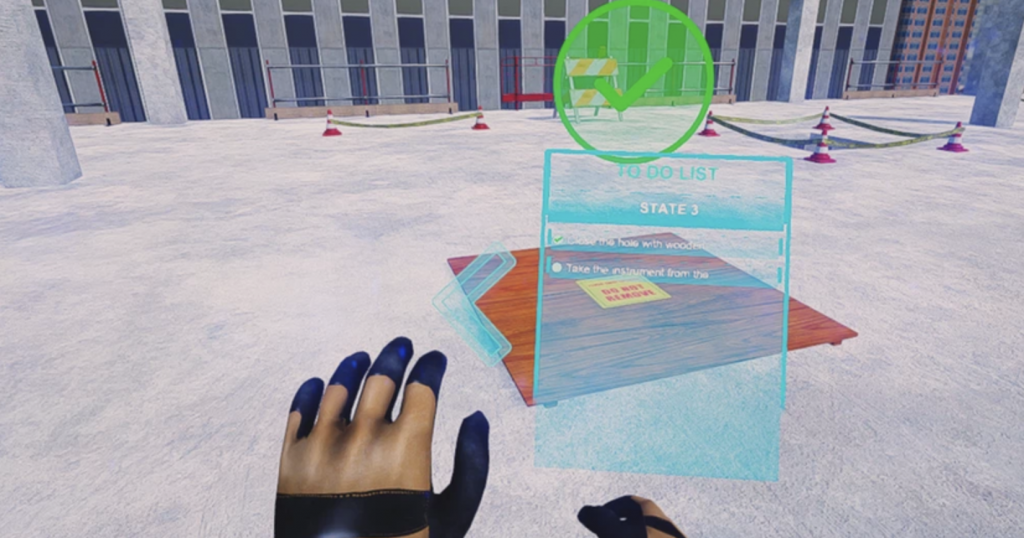
This VR training allows workers to simulate their work on construction sites, train their professional skills, and improve safety knowledge.
Just see the video below.
Retail
Walmart provides an excellent example of how to implement VR training simulation into the retail business.
“When you watch a module through the headset, your brain feels like you actually experienced a situation.”
This is how Walmart US Academies’ senior director Andy Trainor explained why the VR training approach is effective.
Walmart started to use a VR training simulator to train over a million associates across the US.

The company used Rift headsets to train employees to set up and operate their high-tech Pickup Towers. As a result, employees learned and remembered the information quickly, which allowed them to start work faster.
Healthcare
Virtual reality training has a great potential to enhance clinicians’ skillsets and the health sector as a whole. Being immersive, VR training perfectly replicates real-world work allowing healthcare experts to improve their skills without any risks.
For example, surgical training platform Osso VR enables healthcare professionals to practice their surgical skills. The video below shows endoscopy VR training that provides a stunning level of reality and fidelity.
Energy
With VR training simulation, you can ensure electrical safety in your enterprise — just like tech juggernaut Intel did.
With the help of VIVE’s Enterprise, Intel launched an Electrical Safety Recertification course. This VR training course contained immersive learning VR content and realistic risk management scenarios. As a result, the company was able to reduce training costs and increase employees’ effectiveness.
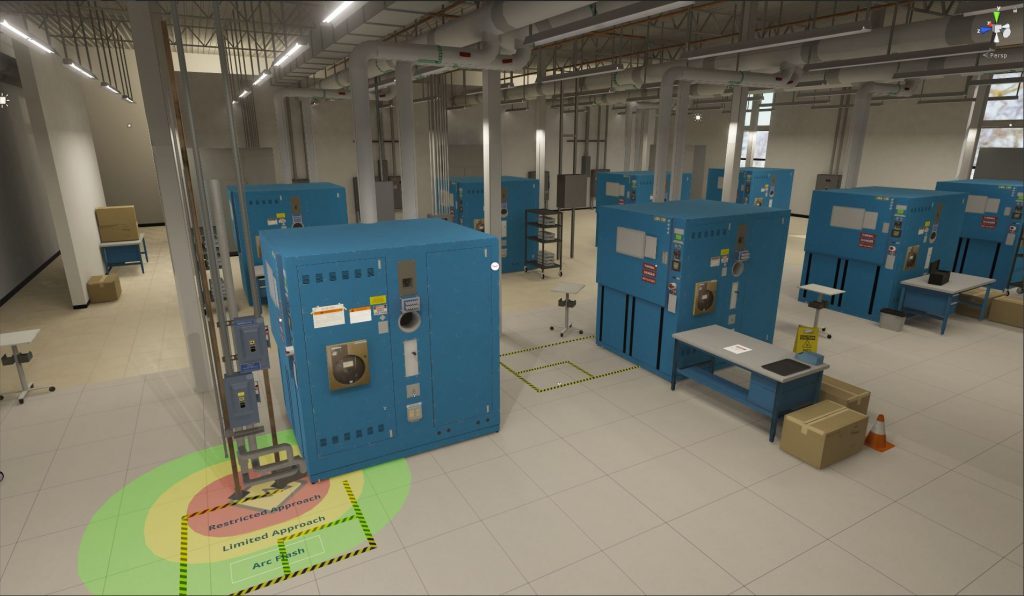
Now that we know what VR training simulation is about, it’s time to consider some must-have VR training simulator features when building a VR training solution.
Features of virtual training simulations
VR training simulation development cost consists of multiple factors, including the number of required features. Before starting VR training simulation development, let’s have a look at the necessary functionality.
We divided the VR training simulation functionality into three main modules: web admin panel, cloud storage, and VR training app.
Web administration panel
This module provides an opportunity to add, edit and delete VR simulation users’ profiles and edit training scenarios.
This module includes the following features:
- The user profiles feature includes creating users accounts that contain personal trainees’ information, their accomplished training programs, and metrics.
- The training programs feature lets administrators create, modify, and add VR training scenarios.
- The trainees’ performance analytics feature automatically assesses trainee’s effectiveness and shows their progress in the dashboard.
- The scheduling of training sessions sends trainees notifications about when the training program begins.
Cloud storage
This module represents databases where you can store user information, 3D models, audio, video, visual assets, training programs.
VR training software
This module looks after running training scenarios, and processing received data from controllers or additional sensors like gloves. Also, VR training software creates audio and visual feedback for such devices as speakers, headsets, or smart glasses.
This module includes the following features:
- In-app video streaming enables recording and playback of past VR sessions.
- Virtual characters enable trainees to communicate with virtual patients, customers, etc.

- Virtual trainer feature represents a 3D character or just voice that provides trainees with required instructions and guidance to complete the session successfully.

- Multi-user sessions enable trainees to pass training with other learners.
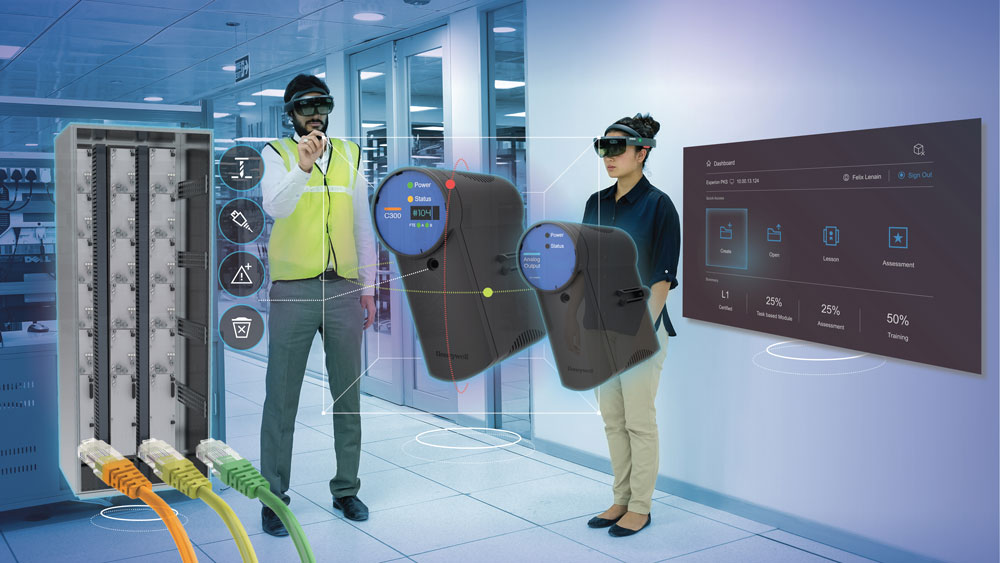
- Gesture-controlled interactions allow trainees to feel even closer to realistic conditions. Using handheld controllers or wired gloves, learners can directly interact with the virtual environment more flexibly.

We’ve just listed the essential functionality required to develop a VR training simulator software.
And now, you may be wondering what technologies are needed to implement all of these features.
Well, let’s consider the technologies and tools needed to create a VR training app.
Required tech stack to build a VR training app
The chosen technologies affect scalability, application maintainability, development time, and costs. If you want your VR app development for corporate training to be successful, it’s wise to be careful when you select a tech stack.
Below, a table shows the technologies and tools we recommend for building a VR training app.
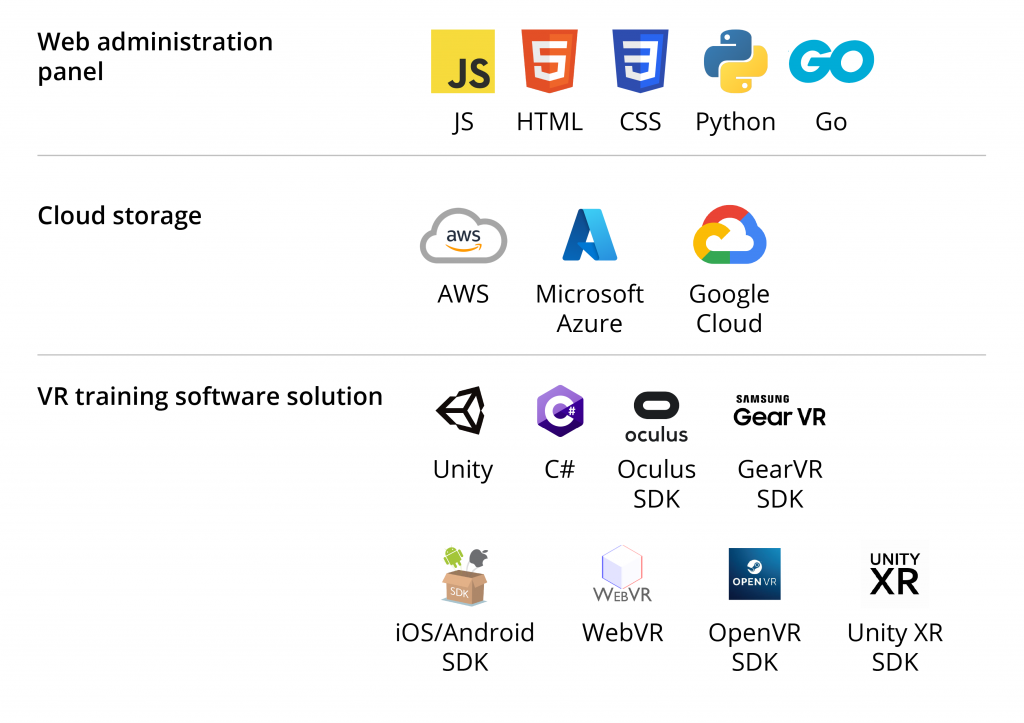
Now that we’ve decided on the technical aspects, we can calculate the approximate cost to build a VR training simulator.
What are the virtual reality training software development costs?
Virtual reality training development cost comprises various factors. Below we provide a list of the main drivers that may influence your development costs.
Required VR app content
You may have various training scenarios, depending on your business field and needs. Usually, VR training development includes content such as:
- 3D environments to create a realistically rendered background
- Animations to provide an excellent user experience
- Virtual characters
- Video and sound effects to make training programs more realistic
- Voice-overs that instructs and guides trainees to complete the session properly
This is the most common and essential VR app content. According to your requirements, developers can add extra objects and elements.
Team size
To calculate the total VR training app development cost, you should also consider the number of specialists you’ll need. Usually, building a VR training app requires a team that looks as follows:
- Project manager
- UX/UI designer
- Developers (backend and frontend)
- QA engineers
- 3D designer
- DevOps
Hardware
One more factor that influences VR training simulator development cost is hardware, namely VR headsets. You’ll need to purchase VR headsets since your VR training simulator now has content that trainees interact with.
Today, there are many choices of VR headsets, for example, Oculus Rift S, HTC Vive, Valve Index, Oculus Quest 2, Google Cardboard, Merge Headset, Pico Neo 2. Headsets cost range from $50 to $1,000.
Below is a comparison of prices for different VR headsets.
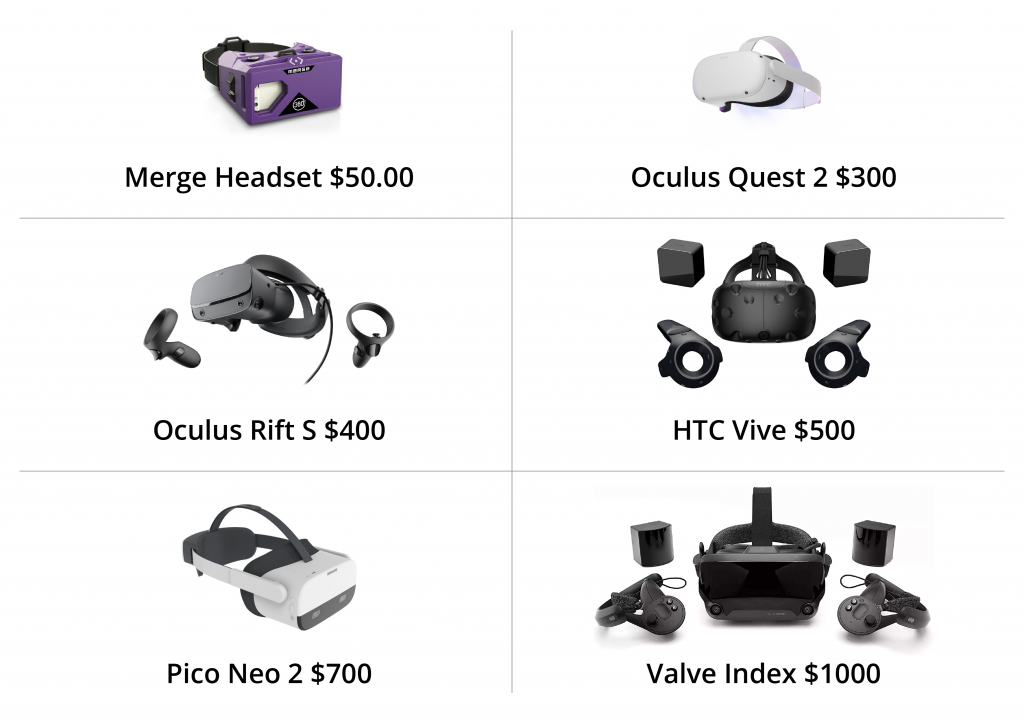
As you can see, there is a wide variety of VR headsets to choose from. Each choice has its own characteristics and parameters. When choosing, you’ll want to consider your goals, requirements, and budget.
Outsourcing development company rate
The most significant factor is the range of outsourcing development company hourly rates across the globe. In the table below, we compare the average cost of VR app development based on rates provided on Clutch.
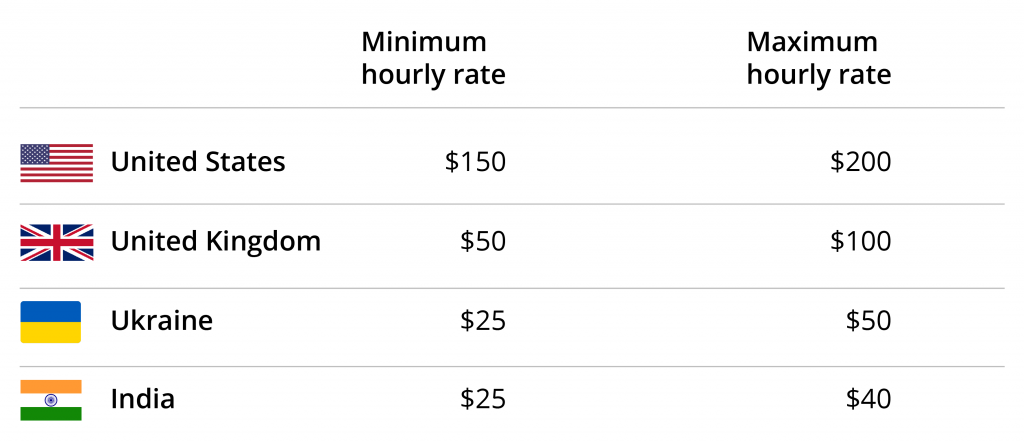
The quality of VR training app development services also varies greatly and can range from subpar to world-class. The trick is finding a balance between quality and price.
Typically, VR training software development includes frontend and backend development and 3D aspects, which involves modeling, UV mapping, animation, VFX, etc. There is an option to buy ready-made 3D assets, but they still need to be optimized.
Building an MVP version of a VR training app with little design work may require approximately 100 hours.
The development of a simple VR training simulation with little interactivity and design requires approximately 320 hours.
And if you want a complex VR training solution with great interactivity and a lot of custom graphics, it is likely to require 8-12 weeks for development.
To roughly calculate VR training app development cost, you can use the following formula: app development time X hourly rate.
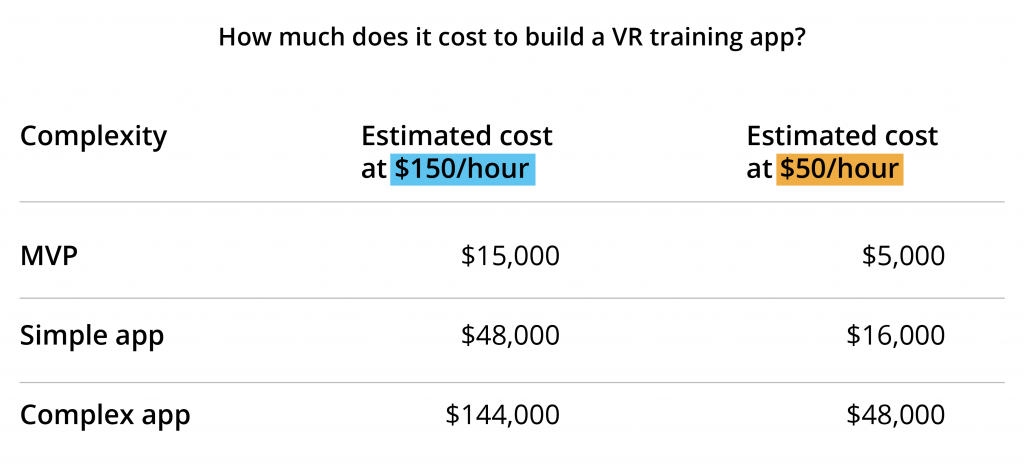
We’ve considered the approximate cost of developing a VR training app. But remember that the amount largely depends on your requirements and the specifics of the project.
Alternative-spaces experience
As a leading development company, the Alternative-spaces team has experienced VR and AR specialists who can help you build top-notch and high-quality VR training solutions that meet your company’s needs, goals, and budget. In this section, we’re going to share with you our experience in building VR training solutions.
The Alternative-spaces team built an immersive and detailed VR experience for healthcare professionals.
Using our VR training app, medical staff can immerse themselves in the thematic story, choosing a training set from the main menu. At the designated points, the system will ask the user for further actions, which will affect the app’s future scenario. Trainees can see hints both in video and audio form. The tree structure allows for creating complex training with the corresponding causative-consecutive results.
As a result, we’ve managed to build a fully-fledged VR medical training app with mobile VR support, 3D stereo 360 video, several controls options, and the tree scenario construction structure.
Ready to revolutionize the way you train your staff?
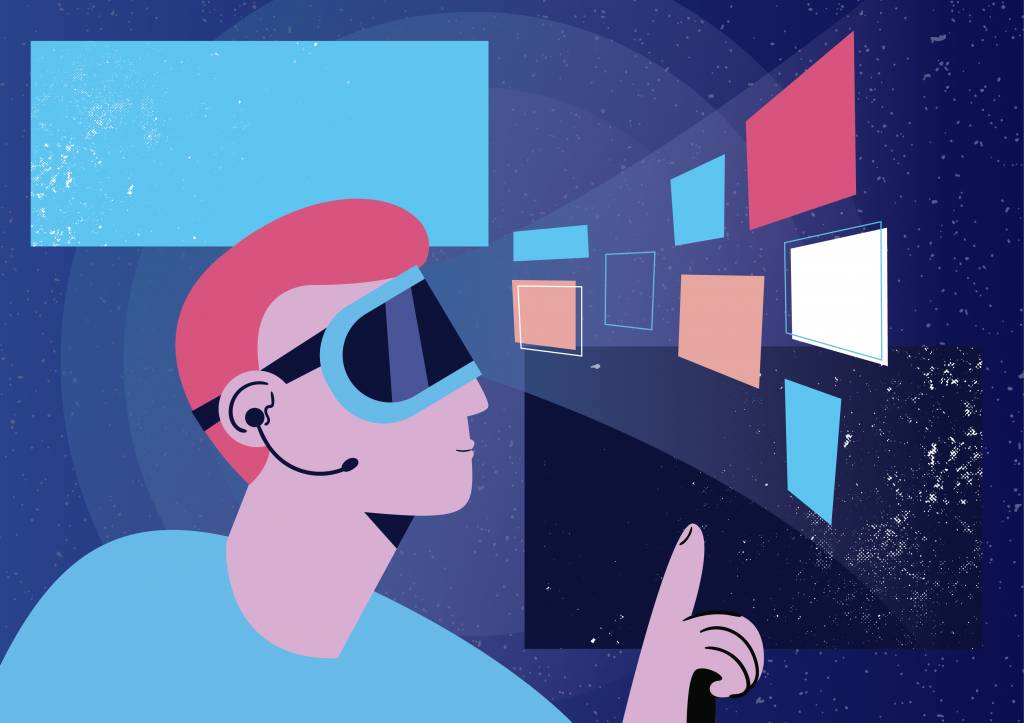
VR technology is the future for much of corporate training.
And while you’re considering whether to implement VR training software, others are already leveraging it. A safe learning environment, fun and realistic experience, key training metrics, and many more advantages are possible when using a VR training app.
Would you like to vastly enhance your corporate training with a progressive VR solution? Please don’t hesitate to get in touch with us, and our experts will create a truly immersive experience for your trainees.
Content created by our partner, Onix-systems.
 Home
Home